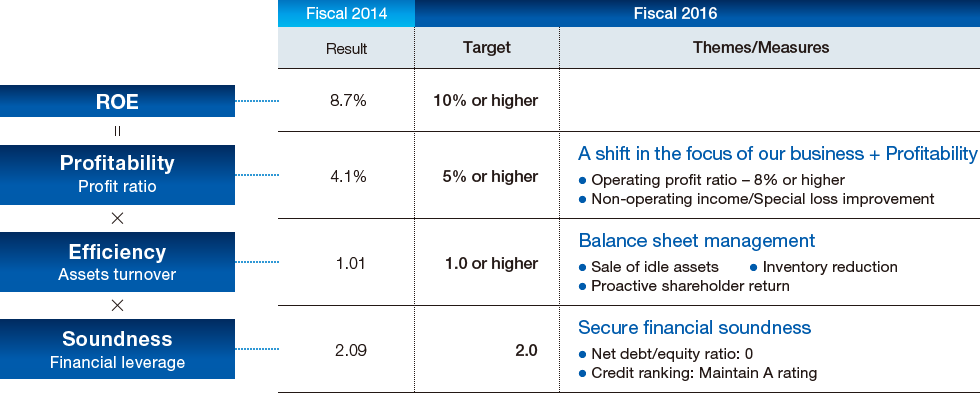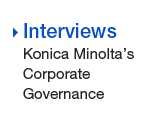![]()
- English
- Japanese
- Worldwide Gateway
- Global
Message from the CFO

- Q1:What does Konica Minolta aim to achieve by applying International Financial Reporting Standards (IFRS) beginning from this term?
- Q2:Konica Minolta is proactively involved in M&As, but how do you intend to deal with impairment risk?
- Q3:A ROE of 10% has been established as one of the targets of the Medium Term Business Plan. Please explain the policies and strategies implemented to achieve this?
- Q4:Please explain the balance sheet management policies such as assets turnover and financial leverage.
 What does Konica Minolta aim to achieve by applying International Financial Reporting Standards (IFRS) beginning from this term?
What does Konica Minolta aim to achieve by applying International Financial Reporting Standards (IFRS) beginning from this term?
 We are aiming to strengthen our ability to disseminate information to investors and improve governance transparency and fairness.
We are aiming to strengthen our ability to disseminate information to investors and improve governance transparency and fairness.
As of the end of June 2015, the Konica Minolta Group has 138 consolidated subsidiaries in approximately 50 countries around the world. The ratio of sales overseas is approximately 80% and foreign investors own about 45% of the outstanding shares. One of the biggest reasons for the voluntary adoption of IFRS beginning from this term is to strengthen our ability to disseminate information to investors in and outside of Japan as a global company, and further increase the reliability of the Group. By adopting IFRS, the only accounting standards utilized uniformly worldwide, we are now able to disseminate financial information in a way that is easy for foreign investors to understand and have simplified the method utilized by Japanese investors to make international comparisons.
Another reason for utilizing IFRS is to strengthen governance. Until now, after our 138 global subsidiaries settled their accounts using the accounting standards of their respective countries, figures were consolidated by converting items to be consistent with Japanese standards. From this time onward, by utilizing a common accounting standard throughout the Group including overseas subsidiaries, it is believed we can improve the transparency and fairness of the Group’s governance, making more appropriate, more efficient capital allocation possible.
 Konica Minolta is proactively involved in M&As, but how do you intend to deal with impairment risk?
Konica Minolta is proactively involved in M&As, but how do you intend to deal with impairment risk?
 We will strengthen risk management for investment projects and improve value by fully leveraging Group synergies.
We will strengthen risk management for investment projects and improve value by fully leveraging Group synergies.
The IFRS require that an impairment test be conducted annually—regardless of any indications of impairment—for the purpose of reevaluating goodwill. In other words, any risk that cannot be eliminated through regular amortization can suddenly amount to a large impairment risk if the performance of the company or business targeted deteriorates.
The Konica Minolta Group began strengthening the risk management of investment projects such as M&As from an early stage, doing so with the plan to significantly reduce impairment risk by adopting IFRS. More specifically, in addition to executing the functions of normal management, several committees have been established. These include the Investment Assessment Committee, Business Assessment Committee and Risk Management Committee, which review individual projects based on a multifaceted approach.
Basically, the Group assesses investment projects using the net present value (NPV) index, which calculates the current investment target value from the cash flow during the investment period. We endeavor to prevent impairment from occurring after M&As by further improving NPV through synergies of the Konica Minolta Group.
 A ROE of 10% has been established as one of the targets of the Medium Term Business Plan. Please explain the policies and strategies implemented to achieve this?
A ROE of 10% has been established as one of the targets of the Medium Term Business Plan. Please explain the policies and strategies implemented to achieve this?
 Our focus is on increasing profit for the year, raising employee awareness and moving forward with the formulation of a code of conduct.
Our focus is on increasing profit for the year, raising employee awareness and moving forward with the formulation of a code of conduct.
Return on equity (ROE) is one of the indicators overseas investors place the most importance on when choosing a stock. For this very reason, we believe it is vital to boost our ROE into the double digits at the earliest possible time; especially considering that 45% of Konica Minolta Group shares are currently owned by foreign investors. Adopting IFRS, the ROE for fiscal 2014 was 8.7%, and our target for the Medium Term Business Plan is to achieve a ROE of 10% or more by fiscal 2016. However, we are now striving to achieve this a year earlier, in fiscal 2015.
The calculation for ROE is as follows: ROE = profit ratio x assets turnover x financial leverage. There are a number of ways to increase ROE; however, the Konica Minolta Group is placing greatest emphasis on increasing the profit ratio for the year.
We have implemented various initiatives such as raising employee awareness and revising assessment systems in order to increase profit for the year. As one of the employee key performance indicators (KPIs) or key goal indicators (KGIs), the Konica Minolta Group places special importance on contributing to operating profit. However, now that we have adopted IFRS, profit such as non-operating profit and extraordinary income and loss other than finance income and loss are also incorporated. This has made it difficult to assess performance and achievement of targets using operating profit alone. Meanwhile, profit for the year is an important indicator that has a direct impact on ROE. Accordingly, we must raise employee awareness of corporate goals and steadily increase profit for the year from now on. However, it is difficult for employees in the field to determine what is required in order to increase profit for the year. This is why we believe it is necessary to establish KPIs and KGIs, which break things down in more detail and provide all employees with a concrete code of conduct.
Progress towards the Medium Term Business Plan of 10% ROE or higher (IFRS base)

- *
- ROE = Profit attributable to owners of the company / (share capital + share premium + retained earnings + treasury shares (average at start of fiscal year and end of fiscal year))
 Please explain the balance sheet management policies such as assets turnover and financial leverage.
Please explain the balance sheet management policies such as assets turnover and financial leverage.
 We implement detailed balance sheet management to suit the characteristics of each business.
We implement detailed balance sheet management to suit the characteristics of each business.
Regarding Group balance sheet management, essentially we are pursuing streamlining and greater efficiency while maintaining a number of important points. One point is securing liquidity, or cash on hand. However, in the case of the Konica Minolta Group, having everything in cash is not required. We have therefore shifted towards an off-balance-sheet approach, which involves counting credit lines from financial institutions as cash on hand and decreasing the assets balance on the balance sheet by that amount.
The second point is managing current assets and current liabilities. Konica Minolta has five business segments and each of these have significantly different accounts receivables-trade, inventory scales, collection periods and so forth. Therefore, the Group works to ensure optimal balance sheet management for each business area utilizing various measures such as checking the cash conversion cycle of each business.
Furthermore, regarding investment and loan activities, we have a policy of proactively using upfront investment necessary for growth. However, we also streamline by excluding items like equipment from balance sheets as much as possible. Finally, in order to suppress financial leveraging, taking management stability into consideration, our policy is appropriate operations that hold it to approximately two-fold from the aspect of intensifying growth investment.
- Download
- Message from the CFO





